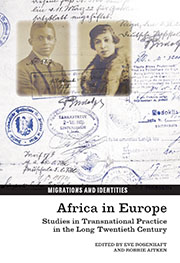Book contents
- Frontmatter
- Contents
- Acknowledgements
- List of Illustrations
- List of Abbreviations
- List of Contributors
- 1 Introduction
- I Enacting Identity: Individuals, Families and Communities
- II Authenticity and Influence: Contexts for Black Cultural Production
- 6 Féral Benga's Body
- 7 ‘Like Another Planet to the Darker Americans’: Black Cultural Work in 1930s Moscow
- 8 ‘Coulibaly’ Cosmopolitanism in Moscow: Mamadou Somé Coulibaly and the Surikov Academy Paintings, 1960s–1970s
- 9 Afro-Italian Literature: From Productive Collaborations to Individual Affirmations
- III Post-colonial Belonging
- IV Narratives/Histories
- Bibliography
- Index
8 - ‘Coulibaly’ Cosmopolitanism in Moscow: Mamadou Somé Coulibaly and the Surikov Academy Paintings, 1960s–1970s
from II - Authenticity and Influence: Contexts for Black Cultural Production
- Frontmatter
- Contents
- Acknowledgements
- List of Illustrations
- List of Abbreviations
- List of Contributors
- 1 Introduction
- I Enacting Identity: Individuals, Families and Communities
- II Authenticity and Influence: Contexts for Black Cultural Production
- 6 Féral Benga's Body
- 7 ‘Like Another Planet to the Darker Americans’: Black Cultural Work in 1930s Moscow
- 8 ‘Coulibaly’ Cosmopolitanism in Moscow: Mamadou Somé Coulibaly and the Surikov Academy Paintings, 1960s–1970s
- 9 Afro-Italian Literature: From Productive Collaborations to Individual Affirmations
- III Post-colonial Belonging
- IV Narratives/Histories
- Bibliography
- Index
Summary
We are a hundred students of different nationalities (Malians, Burkinabès, Ivoirians, Mauritanians, and Chadians) en route to the capital of the enigmatic Soviet Union.
Somé Family Archive, ‘Vers l'inconnu ce 30 Septembre 1961’, Les Labyrinthes du destin
Having left Mali in September 1961, the young Mamadou Somé Coulibaly (1938-98) was en route to the Vasily Surikov Moscow State Academy Art Institute, one of Russia's most prestigious art institutes, in aspiration of becoming an artiste–peintre (Figure 8). The Union Soudanaise–Rassemblement Démocratique Africain (US–RDA), the socialist political party in control of newly independent Mali, sent Somé as one of Mali's cadre of future leaders to become an art instructor and with the expectation that his artistic talents would contribute to the post-colonial revalorisation of Malian art and culture.
For his part, Somé became an executive member of the Jeunesse de l'US–RDA (JUS–RDA) bureau in Moscow, the youth wing of the US–RDA that governed the Malian student body in the Soviet Union. Returning to Bamako in 1972, Somé became the director of the Institut National des Arts (INA), a position he held until 1987. As one of the earliest Malians to receive a Western artistic education, Somé's artistic career and work attest to underlying striations of internationalism and cultural heterogeneity coursing through contemporary art from Mali.
- Type
- Chapter
- Information
- Africa in EuropeStudies in Transnational Practice in the Long Twentieth Century, pp. 142 - 161Publisher: Liverpool University PressPrint publication year: 2013



